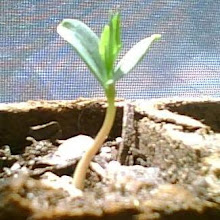I was on an island for two months last summer, in Alaska, collecting data on seabird reproduction for the Fish & Wildlife Service. And of course, there was no washing machine, dishwasher, tap water, jogging path, etc. And we STILL washed our clothes. Though I don't think I'll be hearing much agreement from my mom after I showed up at the Philadelphia airport, direct from Alaska, without a shower. (Which was not my fault. But I digress.)
 (Look -- you can see the laundry hanging in our camp)
(Look -- you can see the laundry hanging in our camp)My views on low-energy laundry do not include getting rid of the washing machine. Having had the experience of washing my clothes in a bucket with stream water, I will say that a washing machine probably does a better job than you can do -- and it can do it using less water than you. But there is something sort of neat about doing laundry by hand. In fact, I think everyone should put themselves in a non-machine situation at some point in their lives, for at least a month. Otherwise, you may never understand how many luxuries you currently, unknowingly, enjoy.
So, the washing machine saves you energy, but you need to supply the rest.
First of all, be a little dirty. I subscribe to the belief that clothing is not dirty until it has either a stain or a scent. I obviously don't advocate re-wearing your underwear, and probably not too often with the socks, but other than that: it's not dirty just because you wore it once.
Another no-brainer is cold-water wash. It takes energy to heat anything. Your cup of tea, the shower water, the seat warmers in your car. So if you use cold water, you save that energy, plus the color in your clothes will probably last longer.
A word on laundry detergent. There are some detergents that are specially formulated to work with cold-water washes; on the island, we used Woolite. My boss was quite explicit on this point, and when a man who regularly spends 1/6 of his year in the wilderness tells you how to do laundry (or how to do anything for that matter), you listen to him, unless you're touched in the head.
However, I'd advise seeking out environmentally friendly soaps. Your local co-op should have a selection to choose from; your local mega store probably doesn't give a crap. Biodegradable soaps are better for all your friendly woodland creatures, and what's good for them is good for you. Or you can make your own, like they did on Going Nuts. Obviously this will take some time and some initial investment in ingredients, but it ends up cheaper in the long run. I personally am going to invest the extra dollar or two in the convenience of having someone else make it for me.
If you're worried about which detergent will best lift those stains or oust that BO, I'd advise you to do a little bit of research -- there are a good number of reviews on the 'net. If it's just the smell thing, though, throw some baking soda in the wash. Baking soda is a great deodorizer. I sprinkled some on my bath towel when it started smelling grody, and now it smells like angels.
Well, no, I haven't ever smelled an angel, but... it smells better than before, okay??
To top it all off, hang dry. Everything. I understand if you're in a rush, or if you're doing your laundry at the laundromat, but lacking a clothesline and pins is no excuse. So far in life, I have had exactly one room at my disposal, and I have always found space to hang things or lay things out to dry overnight. (Like... HANGERS!) If you need something dry for the next day, swipe it with an iron before bed. It's pretty easy.
Just to review... re-wear, cold water wash, eco-friendly soap, and hang dry. The modifications are so slight, but you'll save energy. Another baby step toward saving the world.








